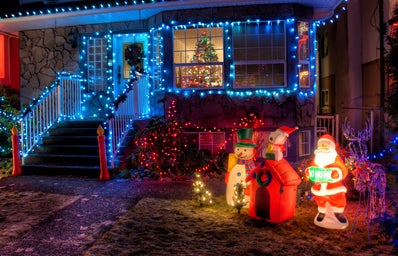This December, take a walk around your neighborhood and keep your eyes peeled. You may notice a very festive war. The minimalists are on one end with effortlessly perfect silver lights, a simple wooden reindeer on the mantle, and no clutter in sight. All of this is wrapped in a pure white color scheme with “daring” gold accents. On the other end are the maximalists with multicolored lights haphazardly strung, a band of electronic singing Santas and absolutely everything red and green.
Maximalism is losing the holiday battle. Minimalism is increasingly popular, especially in interior design. What I have lovingly dubbed “Kitschy Christmas” is now tacky. The message behind the minimalist movement changed, it condemns cluttered decor and creates a decorative hierarchy. For this reason, I propose a Kitschy Christmas revival. Roll out the blow-up snowmen.
The 2000s were all about maximalism. Post-1990 recession was a time of financial prosperity. Status symbol name brands rose in popularity. Designers of the day projected drama, fantasy and high camp. Naturally, the bright colors and cartoonish whimsy of Kitschy Christmas reigned supreme. The recession in the 2010s initiated a period of reflection and priorities were reevaluated. With less disposable income, we turned to minimalism. It was further cemented into American culture after the pandemic.
The pandemic gave us a new self-awareness. We started to consider the social and environmental ramifications of conspicuous consumption. Kitschy Christmas, and to that extent maximalism, was officially dead. Minimalism was a response to the hierarchy that excessive consumerism created, but it became exactly what it wanted to repel. Modern minimalism looks down on inexpensive, mass-produced decorations by emphasizing quality over quantity. They don’t understand that ethical, high-quality design pieces aren’t universally accessible and most staple minimalist items and brands come with appalling price tags. Kitschy Christmas decor is often reused year after year, negating the issue of sustainability.
Criticism of Kitschy Christmas presents a bigger issue. Middle-class consumerism is often faulted for the materialistic nature of our society. Bulk buyers and Black Friday shoppers are ridiculed and considered slaves to consumerism — but are they the real problem? To be a conscious consumer is a privilege that requires enough money to make auxiliary choices. For many consumers, prices make their choices for them, and that is okay.
As a concept, minimalism is simply an aesthetic choice. While I enjoy it, and I think it can be very beautiful, I don’t like negativity towards inexpensive decorations. Kitschy Christmas was part of the excess and maximalism of the 2000s, but a revival could give it the meaning it once lacked. Somewhere in your attic, you might find a piece of kitschy Christmas decor. Why not put it out this year? New Kitschy Christmas represents rejecting holiday conformity and denouncing the stigma around mass-produced decor. Now, time to get my singing Santa out of storage.


